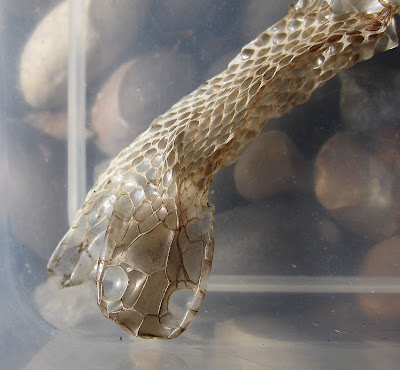 |
| Keston top pond seen from the Westerham Road car park. 14 May 2011. |
Keston Common connects through some wet and dry meadows to the ancient Padmall Wood. Spread around the common and the meadows are small squares of corrugated iron, perfect shelters for snakes and lizards, and Judy aimed to take us around them to see what we could find there today.
Of the six reptiles native to Britain, we might see three today; grass snake, slow-worm, common lizard. There are also adders in the area, living on Hayes Common, but they have not been seen in Keston. Judy showed us some cast-off adders' skins. Grass snakes are present; they have been seen swimming in the top pond, shown in the first photo.
 |
| The head end of the cast skin of an adder, Vipera berus. 14 May 2011. |
First we went up to the acid-soiled heath. Lizards and snakes can tell when someone is coming by the vibrations caused by footsteps, so we crept up to one of the plates and gathered round as Judy carefully lifted it with a crowbar.
This was needed, not because it was heavy, but just in case there was an adder nearby; unlikely, but best not to take an easily avoidable risk.
There was nothing beneath any of the plates on the heath but for some ants and sometimes some signs that something larger might have been there. Then one of the children saw a lizard under a bush! But it ran off before the rest of us could see it. So far, so elusive.
 |
| Cat's ear, Hypochaeris radicata, on Keston Common. |
Sheep's sorrel was widespread; it is an early coloniser of areas which have been scraped to restore the heathland to its former state, as I also saw recently on Hayes Common.
Judy showed us the droppings of a roe deer, distinguishable from round rabbit pellets by their irregular shape and pointed ends. They look like quite small pellets for such a relatively large creature.
We moved on past the sphagnum bog — where cotton grass was visible, common elsewhere but scarce in this area — to a group of meadows, some wet and some dry. These were full of interesting flowers. In the wet meadow we saw pink ragged robin, white milkmaids, and lots of field buttercups. We should look for bog asphodel to flower here in July.
 |
| Female slow-worm, Anguis fragilis, under a metal plate at the edge of a dry meadow in Keston. 14 May 2011. Taken with a Canon EOS 450D and a Canon EF 28-135 f/3.5-5.6 IS USM lens. |
 |
| Common blue damselfly, Enallagma cyathigerum. Male. Dry meadow, Keston, 14 May 2011. |
Judy says that she sometimes finds several slowworms under that particular plate. So we didn't see as many reptiles as we might, but I saw more than I ever have while walking round this common in the past. OK, just one more, but one lizard is much better than none.
Also in this meadow we saw a damselfly clinging to a grass stem. Damselflies are like smaller, more delicate dragonflies and they are all quite beautiful, even this common species. I saw a couple of colourful beetles too, including a red-tipped flower beetle.
We saw field wood-rush and the bright blue eyes of germander speedwell. I was interested to see common or lesser stitchwort, after seeing so much of the larger greater stitchwort in the area. There were groups of bluebells still flowering, and some white star of Bethlehem flowers, which Judy told us don't really belong there.
On the way back, Judy pointed out a treetrunk with an orange stain. This was caused by an alga; algae are normally green but this species contains a carotenoid pigment. This alga, Trentepohlia, can combine with a fungus to form a lichen. The fact that it thrives without the fungus shows just which of the partners in a lichen is getting the better of the deal.
Here are some more images from this very interesting and instructive walk.
 |
| Ragged robin, Lychnis flos-cuculi, in a wet meadow in Keston. 14 May 2011. Taken with a Canon EOS 450D and a Canon EF 28-135 f/3.5-5.6 IS USM lens. |
 |
| Wavy hair-grass, Deschampsia flexuosa, on the acid heath on Keston Common. 14 May 2011. Taken with a Canon EOS 450D and a Canon EF 28-135 f/3.5-5.6 IS USM lens. |
 |
| Common or lesser stitchwort, Stellaria graminea, on a dry meadow in Keston. 14 May 2011. |
 |
| Dropping of a roe deer, Capreolus capreolus. Keston Common acid heath, 14 May 2011. Taken with a Canon EOS 450D and a Canon EF 28-135 f/3.5-5.6 IS USM lens. |
 |
| Judy John addressing the group in a dry meadow in Keston. 14 May 2011. Taken with a Canon EOS 450D and a Canon EF 28-135 f/3.5-5.6 IS USM lens. |
 |
| Judy John cautiously lifting a metal plate on Keston Common. 14 May 2011. Taken with a Canon EOS 450D and a Canon EF 28-135 f/3.5-5.6 IS USM lens. |
 |
| Ash tree stained by an orange alga, Trentepohlia. Keston Common, 14 May 2011. Taken with a Canon EOS 450D and a Canon EF 28-135 f/3.5-5.6 IS USM lens. |
I love wavy hair-grass and, of course, damselflies are lovely, especially photographed in profile. Also, the picture of the tree with orange alga on it is very nice indeed. I see you have a zoom lens for your DSL; I only have the Macro lens. Now back to figuring State income taxes (always due one month after the Federal ones).
ReplyDelete